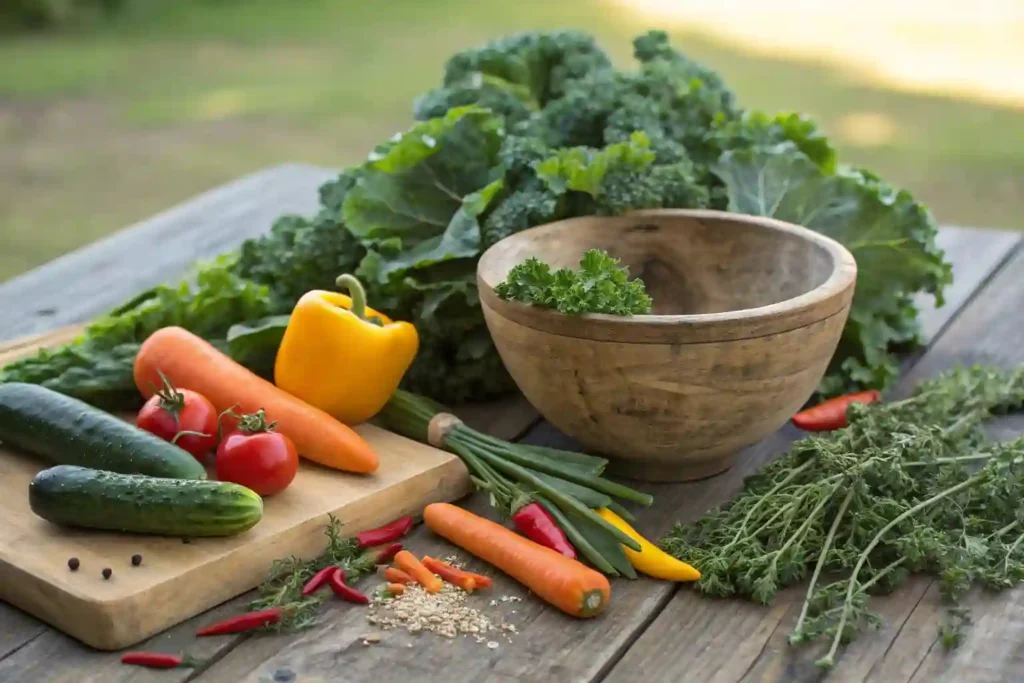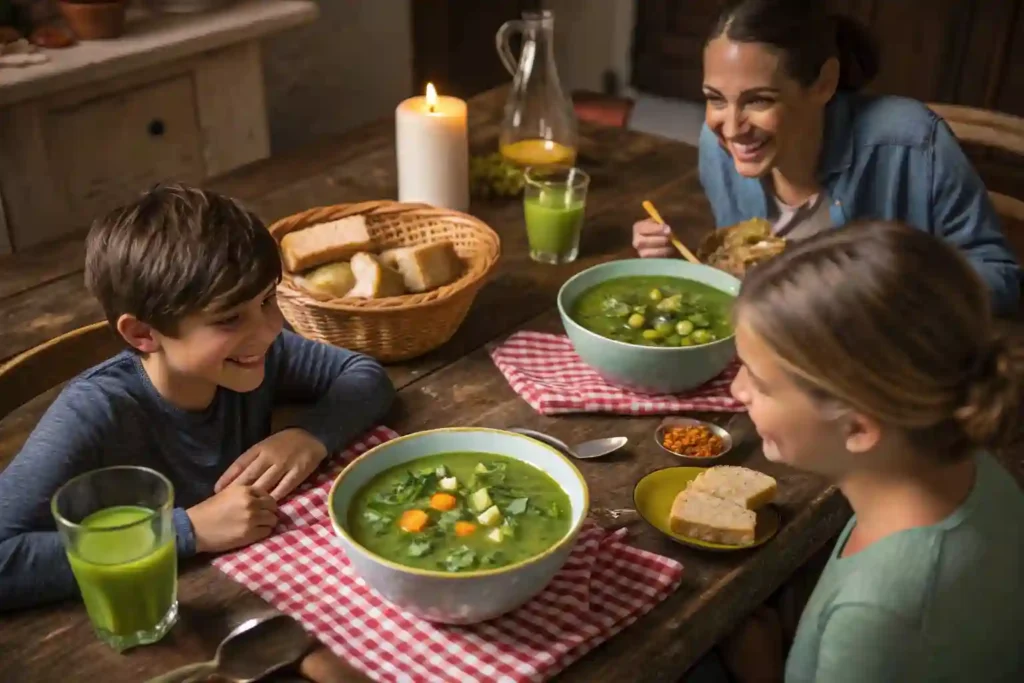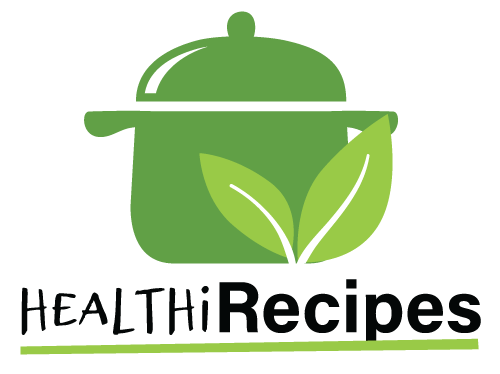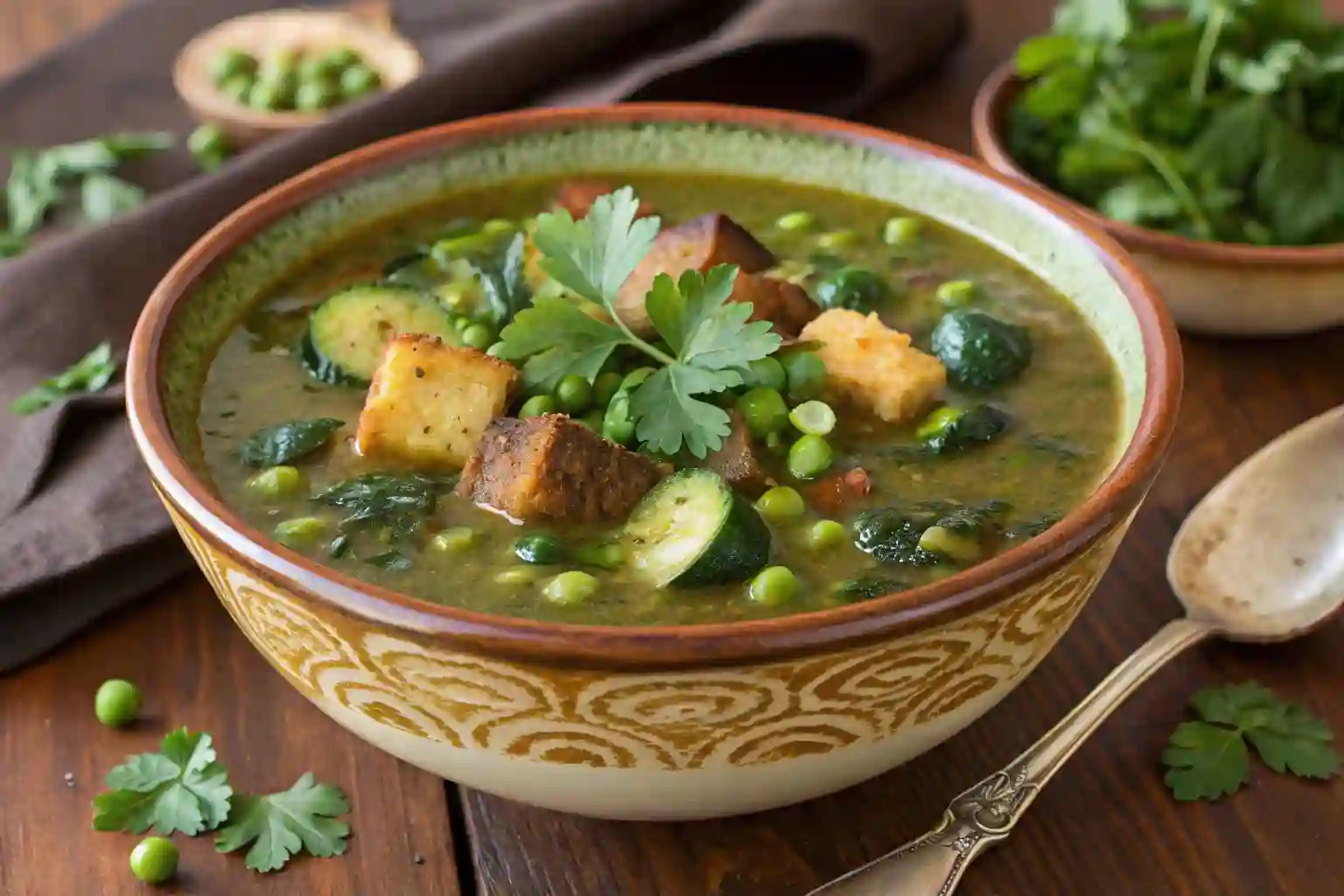If you’re looking for a vibrant and nutritious dish, the Swamp Soup Recipe is a perfect choice. This unique soup, characterized by its rich green color, is not just a meal; it’s an experience. Made with a medley of fresh vegetables, herbs, and spices, swamp soup offers a delightful combination of flavors that will satisfy your taste buds and nourish your body.
Table of Contents
1. What is Swamp Soup?
The Swamp Soup Recipe is characterized by its rich green color, reminiscent of the lush wetlands from which it gets its name. But what exactly is swamp soup made of? The answer lies in a medley of fresh vegetables, herbs, and spices that come together to create a flavorful and nutritious dish. This soup is not only visually appealing but also packed with essential nutrients.
The Origins of Swamp Soup
The origins of the Swamp Soup Recipe can be traced back to various cultures that celebrate the bounty of nature. Traditionally, it has been a way to utilize seasonal vegetables and herbs, making it a sustainable choice for many households. This dish is particularly popular in regions where fresh greens are abundant, allowing for a variety of interpretations and adaptations.
Key Ingredients in Swamp Soup
To create a delicious swamp soup, you’ll need a few key ingredients. Fresh greens such as spinach, kale, or Swiss chard form the base of the soup, providing both color and nutrition. Other essential ingredients include:
- Vegetables: Carrots, celery, and onions add depth and sweetness.
- Herbs: Fresh herbs like parsley, dill, or basil enhance the flavor profile.
- Broth: A good quality vegetable or chicken broth serves as the foundation for the soup.
- Seasonings: Salt, pepper, and a splash of lemon juice brighten the dish.
With these ingredients, you can create a swamp soup that is not only delicious but also a feast for the eyes.s.
2. How to Make Swamp Soup

Creating the Swamp Soup Recipe is a straightforward process that anyone can master. Here’s a step-by-step guide to help you whip up this delicious dish in no time.
Step-by-Step Instructions
- Prepare the Vegetables: Start by washing and chopping your vegetables. Aim for uniform sizes to ensure even cooking.
- Sauté the Base: In a large pot, heat some olive oil over medium heat. Add chopped onions, carrots, and celery, sautéing until they are soft and fragrant.
- Add the Greens: Stir in your choice of greens, allowing them to wilt slightly before adding the broth.
- Pour in the Broth: Add enough broth to cover the vegetables. Bring the mixture to a boil, then reduce the heat and let it simmer for about 20 minutes.
- Season to Taste: Add salt, pepper, and any additional herbs or spices you prefer. A squeeze of lemon juice can elevate the flavors even more.
Tips for Perfecting Your Soup
To make your Swamp Soup Recipe truly stand out, consider these tips:
- Use Fresh Ingredients: Fresh vegetables and herbs will enhance the flavor significantly.
- Experiment with Spices: Don’t be afraid to try different spices to find your perfect blend.
- Blend for Smoothness: For a creamier texture, blend the soup after cooking, but leave some chunks for added texture.
3. Enhancing Flavor in Your Swamp Soup

Creating a delicious swamp soup is not just about the ingredients; it’s also about how you enhance the flavors. A well-seasoned soup can elevate your dish from ordinary to extraordinary. In this section, we’ll explore various techniques to enhance the flavor of your swamp soup.
Adding Depth of Flavor
To truly make your Swamp Soup Recipe shine, consider these methods for adding depth:
- Layering Flavors: Start by sautéing your aromatics (onions, garlic, and spices) before adding the broth. This technique releases essential oils and flavors, creating a robust base for your soup.
- Incorporating Umami: Ingredients like mushrooms, miso paste, or nutritional yeast can introduce umami, the savory taste that enhances the overall flavor profile. Adding a handful of sautéed mushrooms can make a significant difference.
- Using Quality Broth: The broth you choose can make or break your soup. Opt for homemade broth or a high-quality store-bought option. A rich, flavorful broth serves as the backbone of your Swamp Soup Recipe.
- Finishing Touches: After cooking, consider adding a splash of vinegar or a squeeze of citrus. This brightens the flavors and adds a refreshing contrast to the richness of the soup.
Common Mistakes to Avoid
While making swamp soup can be straightforward, there are common pitfalls to watch out for:
- Overcooking Vegetables: Cooking vegetables for too long can lead to a mushy texture. Aim for a tender-crisp finish to maintain their integrity.
- Neglecting Seasoning: Many home cooks forget to season their soup adequately. Taste as you go and adjust the seasoning to ensure a well-balanced flavor.
- Skipping Fresh Herbs: Fresh herbs can transform your soup. Adding them at the end of cooking preserves their vibrant flavor and aroma.
Creative Variations of Swamp Soup
Swamp soup is versatile, allowing for numerous variations. Here are a few ideas to inspire your creativity:
- Protein Boost: Add cooked beans, lentils, or shredded chicken for a heartier meal.
- Spice It Up: Incorporate spices like cumin or chili powder for a kick of heat.
- Creamy Texture: For a creamier version, blend a portion of the soup and stir it back in, or add a splash of cream or coconut milk.
4. FAQs About Swamp Soup
In this section, we’ll address some frequently asked questions about swamp soup and soup-making in general. These insights will help you understand the nuances of creating a flavorful and satisfying dish.
What is green soup made of?
Green soup typically consists of a variety of fresh greens, vegetables, and herbs. Common ingredients include spinach, kale, peas, and herbs like parsley or basil. The base is often a flavorful broth, which can be vegetable or chicken-based. The combination of these ingredients not only gives the soup its vibrant color but also packs it with nutrients and flavor.
How to make homemade soup more flavorful?
To enhance the flavor of homemade soup, consider the following tips:
- Start with a Flavorful Base: Sauté onions, garlic, and spices before adding liquids. This builds a strong foundation for your soup.
- Use Quality Ingredients: Fresh, high-quality vegetables and herbs will significantly improve the taste of your soup.
- Season Gradually: Add salt and spices in stages, tasting as you go. This ensures a well-balanced flavor.
- Incorporate Umami: Ingredients like mushrooms, soy sauce, or Parmesan cheese can add depth and richness to your soup.
How do you add depth of flavor to vegetable soup?
Adding depth to vegetable soup can be achieved through several techniques:
- Roasting Vegetables: Roasting vegetables before adding them to the soup can intensify their flavors.
- Using Stock Instead of Water: Always use stock or broth instead of water for a richer taste.
- Adding Acid: A splash of vinegar or lemon juice at the end of cooking can brighten the flavors and add complexity.
What makes a bowl of soup more flavorful?
Several factors contribute to a more flavorful bowl of soup:
- Layering Ingredients: Building flavors by adding ingredients in stages can create a more complex taste.
- Fresh Herbs and Spices: Adding fresh herbs at the end of cooking preserves their flavor and aroma, enhancing the overall dish.
- Texture Variations: Combining smooth and chunky textures can make the soup more interesting and enjoyable.
- Finishing Touches: A drizzle of olive oil, a dollop of sour cream, or a sprinkle of cheese can elevate the presentation and flavor of your soup.
5. Final Thoughts on Swamp Soup
Final Thoughts on Swamp Soup
Swamp soup is not just a dish; it’s a celebration of fresh ingredients and creativity in the kitchen. Whether you’re making it for a cozy family dinner or a gathering with friends, this vibrant soup is sure to impress. By following the tips and techniques outlined in this article, you can create a swamp soup that is both delicious and visually appealing.
Experimenting with Ingredients
One of the best aspects of swamp soup is its versatility. Feel free to experiment with different greens, vegetables, and spices to create your unique version. Seasonal ingredients can inspire new flavors, making each batch of swamp soup a delightful surprise.
Serving Suggestions
When serving swamp soup, consider pairing it with crusty bread or a fresh salad for a complete meal. A sprinkle of croutons or a dollop of sour cream can add an extra layer of texture and flavor. Additionally, serving the soup in vibrant bowls can enhance its visual appeal, making it even more inviting.
Storing and Reheating
If you have leftovers, storing swamp soup is easy. Allow it to cool completely before transferring it to an airtight container. It can be stored in the refrigerator for up to three days or frozen for longer storage. When reheating, add a splash of broth or water to restore its consistency.
Conclusion
In conclusion, swamp soup is a delightful dish that embodies the essence of Southern comfort food. This recipe is not only easy to prepare but also allows for customization based on your preferences. For a heartier meal, consider pairing it with Smoked Queso or Chicken Tenders, both of which complement the flavors of the soup beautifully. Additionally, for a classic take on swamp soup, check out Simply Recipes for a traditional recipe that highlights the rich culinary heritage of the South. Embrace the warmth and comfort of this dish, perfect for family gatherings or a cozy night in. With its robust flavors and satisfying ingredients, swamp soup is sure to become a favorite in your recipe collection!

